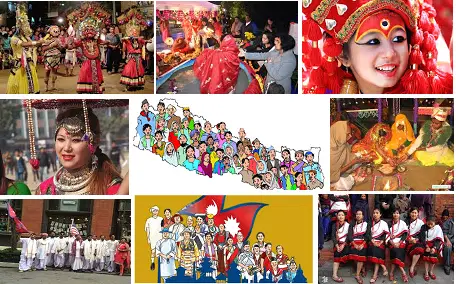Nepali Culture
Culture is the features and knowledge of a particular group of people, including social practice or habits, clothes design, marriage, customs, language, religion, arts, music, food, and festivals,
It is has been derived from the way of life in a particular society in Nepal. Nepali/Nepalese culture is one of a kind and is somewhat to combination in the society.
Culture also can define as shared outlines of behaviors, believes, and interaction, construct, and understanding, which educated by the socialization process. So, it can be looked like the development of group identity shaped by social forms unique to the particular group of people.
Nepali Constitution recognized as Nepal is collectively constituting the nation with multiethnic, multilingual, multi-religious, multi-cultural characteristics. Nepal has focused to protect and promote social and cultural values.
But, no person can discriminate against anybody in the name of culture and customary practice bases on based on class, caste, region, language, religion, and gender. All forms of caste-based untouchability, discrimination shall be punishable by the Nepali Laws.
Nepali culture has been passing from one generation to another. It is a valuable wealth that the Nepali setting with a feeling of enormous pride.
Nepal has a place of diversity in all parts, ethnicity, religion, customary practice, tradition, thus cultures of Nepal also diverse.
The culture of Nepal is a comprising of its ethnicity, religions, norms and values, and beliefs, race/tribes, and community. The culture of Nepal is a symbol of the nation’s unity, wealth, harmonized, and varied society.
- Different Ethnicity of Nepal
Nepal has a multi-ethnic culture. The identity of Nepal is developed on the different geography of the nation.
For the most part, there are three sorts’ ethnic gatherings in Nepal; to be specific Indigenous-Nepalese, Indo-Nepalese, and Tibeto-Nepalese.
Indigenous Native Nepalese and Indo-Nepalese are the local areas of Southern Asia. The Tibeto-Nepalese are accepted to have comes from Tibet and got comfortable the hilly areas of Nepal.
Indo-Nepalese, who relocated from India live in the Hilly and Terai areas of the country. These incorporate the ripe terrains, and subsequently, their essential occupation during the old occasions was cultivating. The Indian ways for the most part impact.
Their way of life and the Indo-Nepalese have an Aryan composition. They make the greater part out of Nepal’s populace, and their range can be found in practically all locales of Nepal.
Tibeto-Nepalese culture is like Tibetan culture’s way of life, and they have a Mongoloid look. They wear an extraordinary dress called Bakkhu and Docha, that are thick garments appropriate for chilly climate and Hill regions.
Their way of life is profoundly established in conventional Nepalese manners. They for the most part live in uneven areas of the country. The native individuals cosmetics about 35.81% of the all-out populace of Nepal and extremely different inside themselves as well.
- Nepali Religion
Later to the declaration of secularism and constitutionalized in the Nepalese constitution, Nepal has been neutral on the matters of religion.
Nepal accepted and respect all religions as it enhances the diversity of culture in Nepal.
From ancient times Hindu religion also called Sanatan Dharma seems like the dominant religion in the country.
Nepal was previously a Hindu religious Nation before 2009, and approximately 81.3 percent of the total population of Nepal are Hindus.
Largely Nepalese cultures and traditions are influenced by Hinduism, because of the high number of admirers of Hinduism.
The second most dominant religion maybe Buddhism, it is nine percent of the total population. The remains of the community follow Islam with 4.4 percent, Kiratism three percent, Christianity 1.5 percent, and others 0.6 percent.
The perfect coordination between the admirers of several religions is really a wonder. Many Hindu and Buddhist religious places are interconnected and combined. This is an illustration of the agreement and sensation of fellowship that exists in the Nepalese culture.
- Festivals in Nepal
Nepal is a Multi-religious and multi-cultural characteristic community that contributes to the various festivals practiced every year.
Actuality, fundamentally influenced by the Hindu and Buddhist people group, the greater part of the celebrations are identified with them. The greater part of the celebrations in Nepal is attached to some social and customary qualities.
The Nepalese culture of putting Tika in the Dasain is an impulse in the greater part of the celebrations. The most favorable celebration of Nepal is viewed as Dashain, which is commended for ten days.
Followed by the Dashain celebration is Tihar, which is commended for five days in which consistently has its specific importance.
Buddhist and Newar community also celebrated Dasain and Tihar, with their won practice and believes different from Hindu’s celebration.
Likewise, people of the Terai area love the sun, this celebration is known as Chhath. It is to thank the sun for supporting life on earth.
Individuals from the mountain district additionally notice the Tibetan New Year as Losar, multiple times in a year for various ethnic gatherings! These feature the rich and assorted culture of Nepal.
- Language and Literature of Nepal
Nepal is a multi-linguistic country, there 123 languages spoken in Nepal. The official language of Nepal is Nepali. The provincial government can use most speaks the local language as official language additional to the Nepali language.
Basically, the Nepali language is spoken throughout Nepal, someplace as mother tongue, and some areas as secondary or communicating language. The most spoken languages are Nepali, Maithili, Bhojpuri, Tharu, Awadhi, Magahi, and other languages.
Conclusion
The culture of Nepal is pretty energizing and diverse. It absolutely is something that one should not miss. With the assorted identity and topography, Culture in Nepal should be capable direct at any rate once in the course of their life.


